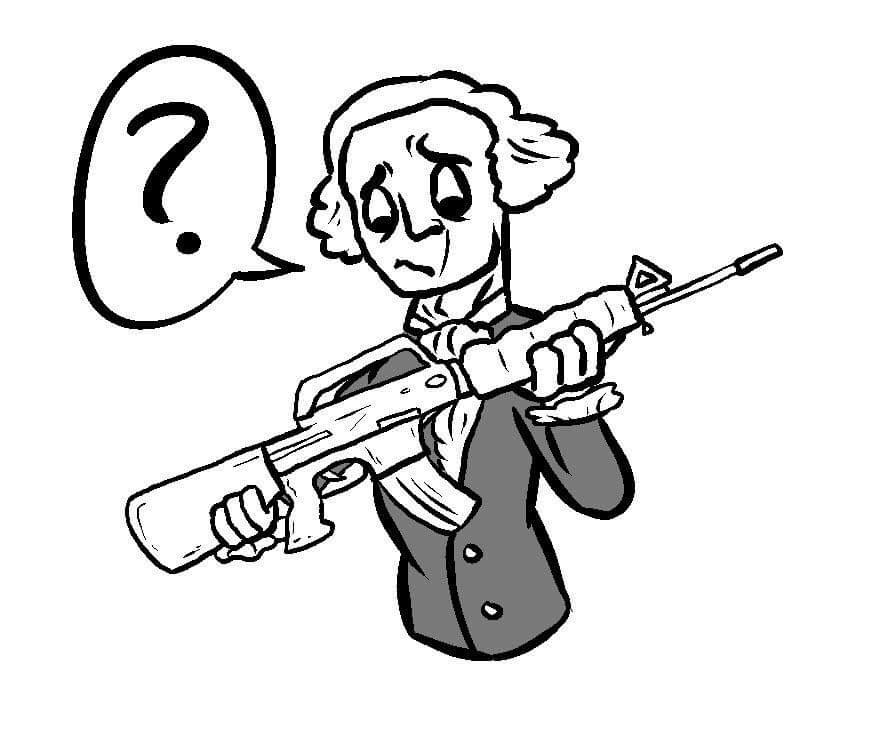Why the Second Amendment stuck around
March 31, 2018
On Feb. 14, 2018, 14 students and three faculty members were shot and killed at a high school in Parkland, Florida. The teenage survivors have since become faces of a nationwide movement calling for stricter gun control laws to be passed.
With each mass shooting, the gun control debate emerges and re-emerges. At its center is what the Second Amendment, ratified in 1791, actually means.
“Today, you have a lot of people who have a love-affair with their gun,” said associate professor of History and Assistant Director for Public History Dr. Brian Hackett.
“‘I’m a proud gun-owner.’ Back in the 18th century, that would have been a really foreign term. That’s like saying ‘I’m a proud hammer-owner.’”
The first gun debates began with the Constitution’s inception. A group known as anti-federalists raised a number of objections to the Second Amendment, according to Chase Law professor John Bickers.
“They feared the federal government was going to take too much power from the states,” Bickers said. “[James] Madison made the argument, as a promoter for ratification, ‘Let’s do this and we’ll add a Bill of Rights.’’
Hackett said the Bill of Rights were added as a concession.
“You really had two parties fighting each other: A group that wanted a strong, central government and a group that didn’t want a strong, central government,” Hackett said. “Eventually, the people that wanted a strong, central government won.”
Hackett added that the chaotic state of the country contributed to the Bill of Rights. Uncertainties about the United States’ future and its fledgling government left many concerned about stability.
At the time, citizens began to question what kind of government they wanted, and how the country would be run.
“We had just gotten rid of a government far away that dictated and told people what to do,” Hackett said. “Now what are we going to have? Are we going to have something similar to what we had before, or something completely different?”
Bickers said there is one thing about the Second Amendment that people tend to forget.
“The Second Amendment is a puzzle and it’s been a puzzle ever since. And, partly, it’s a puzzle because of something that we tend to forget now, which is that the Bill of Rights never applied to the states. They just didn’t,” Bickers said.
“The first ten amendments, you really need to think about them as not broad guarantees to the freedom of the American people; they are specific limits on the federal government.”
Chase professor Ken Katkin, who specializes in Constitutional law, said it’s hard to determine why the Second Amendment was included in the Bill of Rights because there’s little documentation left from the framers.
“They had a practice where they would meet in the Constitution Hall everyday in Philadelphia while they were working on the Constitution and people were allowed to take notes and things just so they could keep track of where they were in the conversation,” Katkin said. “But everybody had to burn their notes before they left each day and the reason was, they never wanted anybody looking at any of that stuff.”
James Madison, the secretary of the convention, was sworn to secrecy for 50 years, but published his notes when that time ran out, according to Katkin.
Although Madison’s notes are available, Katkin said there is still little evidence to gather.
“Different framers expressed different ideas about it at different times,” Katkin said. “Probably the most aggressive interpretation that you’ll hear is that they wanted citizens to have the right to bear arms so that citizens could overthrow the government, if the government were to become tyrannical.”
“What does the Second mean? Well, it’s weird, of course, because it’s one of only two places in the constitution that has a prefatory clause. What does that mean? Is that a limit? Is it just a statement? For years, there was no federal litigation about the Second Amendment,” Bickers said.
Bickers said after the Civil War, the reconstruction amendments–13,14,15–were added, creating limits on the states and how they deal with citizens.
“A number of states forbade the possession of weapons by African Americans. That was a real concern that you disarmed the most vulnerable segment of society to allow them to be harassed and terrorized by the Klu Klux Klan,” Bickers said.
Some states passed a law saying that they could not deprive citizens of equal protection, life, liberty and the pursuit of happiness without due process of law. States started incorporating Bill of Rights guarantees.
Bickers said the only time the Second Amendment came up during that time was in a case called United States v. Cruikshank.
“In Cruikshank, a group of white terrorists had committed just a mass killing of African American activists—sort of at the end of reconstruction. They were tried federally because no state jury would convict them. They were tried federally for violating civil rights, and one of the civil rights mentioned was the right of the murdered men to have firearms,” Bickers said. “And the court said ‘that’s not really the kind of constitutional right we need to worry about.’ But that case is kind of lost in history—you don’t see it mentioned except to be criticized.”
The next case, according to Bickers, involving the Second Amendment was Miller v. United States(1939), where the Roosevelt administration put a tax on firearms in 1934.
“There was a federal firearm law and it’s called a ‘firearm law’ but then the way it describes firearms isn’t the way any regular person would describe firearms,” Bickers said. “Because it doesn’t apply to the vast majority of firearms.”
Miller was criminally charged with possessing a firearm without paying the fee, according to Bickers.
“The Supreme Court said ‘Second Amendment doesn’t help you, pal. It doesn’t help you because the Second Amendment starts with this militia clause.’ And that’s very important because the next time we have the Supreme Court weigh in on it is the District of Columbia vs. Heller case,” Bickers said.
The 2008 Supreme Court case ruled that the Second Amendment allows a person to bear arms, despite the militia clause, according to Bickers.

Katkin said that in the past, some statutes required citizens to bear arms because of the militia cause.
“Other interpretations that have been offered—the Second Amendment does have this preamble. Unlike any other amendments in the Bill of Rights, the Second Amendment is the only one that starts with a few words that tell you a little bit about why it’s there.”
Katkin said one of the ideas about the creation of the Second Amendment might have been included was because there would have been no permanent standing army to defend against threats, such as the British coming back.
“And, so, the well-regulated militia concept would be the concept that the people should bear arms, so that in the event of an emergency, they could be called up and they could form a local militia that could provide defense because the army really wouldn’t have any ability to do that everywhere in the United States,” Katkin said.
Despite the current size of the Department of Defense and military, the Constitution prohibits appropriations for defense to last more than two years, Katkin said.
“So, the idea was that if we have to have an army, they’ll have to appropriate money for it, and in the years when there’s no need for it, they won’t appropriate money for it,” Katkin said. “They really had all these ideas that we would need to raise up armies in times of war, we wouldn’t necessarily keep them in times of peace, but then we would need to have militias in times of peace.”
Katkin said the arms available when the Second Amendment was written are not the same as arms available today.
“Muskets were about the most powerful arms, maybe cannons,” Katkin said. “There just wasn’t the kind of lethality that we would associate with arms today. Early legislation on gun control wouldn’t look like what people are thinking about today.”
“The question today that people struggle with is ‘exactly what they meant?’ Did the founding fathers imagine an AR-15, when they were writing [the Bill of Rights] or were they thinking flintlock muskets?,” Hackett said.
Katkin said that owning guns allowed people to be self-sufficient.
“It enables one to be fearless. It enables one to undertake dangerous endeavors. I think those are—sort of—the positive aspects of American gun culture,” Katkin said. “And there’s even this element of ‘helps preserve our democracy by providing a check against the government tyranny.’’
“Certainly, you associate the image of the gun with the pioneers who settled the west. By having the gun, they could go out into the unknown and they could use it to kill animals, to eat and they could protect themselves if they were attacked against Indians.”
Hackett said times have changed with how people associate themselves with their guns.
“It’s a tool. It was just something they used, either in your daily life to support yourself or kill for protection. There was no aura of ‘I have this gun as opposed to that gun.’ It’s kind of strange that people would actually say ‘I’m proud of this.’ Because to them, it was a tool.”

